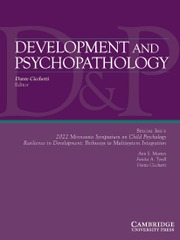Crossref Citations
This article has been cited by the following publications. This list is generated based on data provided by
Crossref.
Baker, Sabine
2018.
Handbook of Parenting and Child Development Across the Lifespan.
p.
217.
Pauen, Sabina
Strodthoff, Constanze Anna
and
Bechtel-Kühne, Sabrina
2019.
Kindliche Selbst- und elterliche Ko-Regulation parallel erfassen.
Kindheit und Entwicklung,
Vol. 28,
Issue. 1,
p.
46.
Calkins, Susan D.
Dollar, Jessica M.
and
Wideman, Laurie
2019.
Temperamental vulnerability to emotion dysregulation and risk for mental and physical health challenges.
Development and Psychopathology,
Vol. 31,
Issue. 3,
p.
957.
Dollar, Jessica M.
and
Calkins, Susan D.
2019.
Handbook of Emotional Development.
p.
199.
Cibralic, Sara
Kohlhoff, Jane
Wallace, Nancy
McMahon, Catherine
and
Eapen, Valsamma
2019.
A systematic review of emotion regulation in children with Autism Spectrum Disorder.
Research in Autism Spectrum Disorders,
Vol. 68,
Issue. ,
p.
101422.
Berry, Daniel
Palmer, Alyssa R.
Distefano, Rebecca
and
Masten, Ann S.
2019.
Autonomic complexity and emotion (dys-)regulation in early childhood across high- and low-risk contexts.
Development and Psychopathology,
Vol. 31,
Issue. 3,
p.
1173.
Reid, Natasha
Harnett, Paul
O’Callaghan, Frances
Shelton, Doug
Wyllie, Melissa
and
Dawe, Sharon
2019.
Physiological self-regulation and mindfulness in children with a diagnosis of fetal alcohol spectrum disorder.
Developmental Neurorehabilitation,
Vol. 22,
Issue. 4,
p.
228.
Huber, Laura
Plötner, Maria
In-Albon, Tina
Stadelmann, Stephanie
and
Schmitz, Julian
2019.
The Perspective Matters: A Multi-informant Study on the Relationship Between Social–Emotional Competence and Preschoolers’ Externalizing and Internalizing Symptoms.
Child Psychiatry & Human Development,
Vol. 50,
Issue. 6,
p.
1021.
Marçal, Katherine E.
2020.
Demographic and Socioeconomic Predictors of Behavioral Trajectories from Age 3 to 15: A Longitudinal Mixed Effects Approach.
Journal of Child and Family Studies,
Vol. 29,
Issue. 7,
p.
1818.
Sellers, Ruth
Harold, Gordon T.
Thapar, Anita
Neiderhiser, Jenae M.
Ganiban, Jody M.
Reiss, David
Shaw, Daniel S.
Natsuaki, Misaki N.
and
Leve, Leslie D.
2020.
Examining the Role of Genetic Risk and Longitudinal Transmission Processes Underlying Maternal Parenting and Psychopathology and Children’s ADHD Symptoms and Aggression: Utilizing the Advantages of a Prospective Adoption Design.
Behavior Genetics,
Vol. 50,
Issue. 4,
p.
247.
Memmott‐Elison, Madison K.
Moilanen, Kristin L.
and
Padilla‐Walker, Laura M.
2020.
Latent Growth in Self‐Regulatory Subdimensions in Relation to Adjustment Outcomes in Youth Aged 12–19.
Journal of Research on Adolescence,
Vol. 30,
Issue. 3,
p.
651.
Tetering, M. A. J. van
Laan, A. M. van der
Kogel, C. H. de
Groot, R. H. M. de
Jolles, J.
and
Slobodskaya, Helena R.
2020.
Sex differences in self-regulation in early, middle and late adolescence: A large-scale cross-sectional study.
PLOS ONE,
Vol. 15,
Issue. 1,
p.
e0227607.
Samdan, Gizem
Kiel, Natalie
Petermann, Franz
Rothenfußer, Selina
Zierul, Claudia
and
Reinelt, Tilman
2020.
The relationship between parental behavior and infant regulation: A systematic review.
Developmental Review,
Vol. 57,
Issue. ,
p.
100923.
Claire, Hughes
2020.
Neural Circuit and Cognitive Development.
p.
539.
Mueller, Marie A.E.
and
Flouri, Eirini
2020.
Neighbourhood greenspace and children's trajectories of self-regulation: Findings from the UK Millennium Cohort Study.
Journal of Environmental Psychology,
Vol. 71,
Issue. ,
p.
101472.
Russell, Catherine G.
and
Russell, Alan
2020.
“Food” and “non-food” self-regulation in childhood: a review and reciprocal analysis.
International Journal of Behavioral Nutrition and Physical Activity,
Vol. 17,
Issue. 1,
Williams, Kate E.
and
Bentley, Laura A.
2021.
Latent Profiles of Teacher-Reported Self-Regulation and Assessed Executive Function in Low-Income Community Preschools: Relations With Motor, Social, and School Readiness Outcomes.
Frontiers in Psychology,
Vol. 12,
Issue. ,
Kjeldsen, Anne
Nes, Ragnhild Bang
Sanson, Ann
Ystrom, Eivind
and
Karevold, Evalill Bølstad
2021.
Understanding trajectories of externalizing problems: Stability and emergence of risk factors from infancy to middle adolescence.
Development and Psychopathology,
Vol. 33,
Issue. 1,
p.
264.
Schuetze, Pamela
Godleski, Stephanie
and
Sassaman, Jenna
2021.
Prenatal exposure to opioids: Associations between the caregiving environment and externalizing behaviors.
Neurotoxicology and Teratology,
Vol. 87,
Issue. ,
p.
107019.
Constanty, Lauriane
Lepage, Caroline
Rosselet Amoussou, Joëlle
Wouters, Emilie
Decoro, Velia
De-Paz, Lisa
Hans, Charlotte
Ergüneş, Hazal
Sangra, Jonas
Plessen, Kerstin Jessica
and
Urben, Sébastien
2021.
Non-Pharmaceutical Interventions for Self-Regulatory Failures in Adolescents Suffering from Externalizing Symptoms: A Scoping Review.
Biomedicines,
Vol. 9,
Issue. 9,
p.
1081.

